Introduction
If you are like me, you are always on the lookout for fast wide angle lenses that have good performance when shooting night time landscapes that have starry skies overhead. In particular, I will be looking at some new lenses (and some older ones) that can render stars as points of light. I’m not considering lenses for star trail photos, although many of the same characteristics are applicable. Also, I am only considering full frame 35 mm digital cameras (and lenses for these cameras) for reasons that will be touched on in the following discussion.
Some of the challenges faced when attempting these night shots are:
1. Gather as much light onto the camera sensor as possible in as little time as possible.
The reason for this is fairly obvious. There is not much light available at night so a large aperture (small F number) is needed to let as much light as possible pass through the lens. Ideally, one would open the lens aperture as much as possible to allow the most light to hit the camera sensor. While a star exposure is being made (over multiple seconds), the earth is rotating on its axis causing apparent star streaking. This is why time of exposure must be kept relatively small. When I say relatively small for exposure time, some streaking is allowable while still keeping the stars at nearly points of light. How much streaking will occur depends on both the exposure time and the lens focal length. Wide angle lenses will stretch the background (sky), making distances appear larger that normal. The star streaking distance will appear to be smaller over the wide angle perspective, allowing exposure to be longer before objectionable streaking occurs.
So what are the practical implications on lens selection? First, for landscapes with stars, only wide angle lenses are usually used. In most practical cases, lenses wider that 35mm (full frame camera) are used, and even more often, lenses 24mm or wider are used. There is a quick rule of thumb to calculate how long an exposure can be before stars start to streak to an objectionable extent. Objectionable extent is clearly subjective and each photographer has his own threshold. The rule of thumb is to divide the focal length of your lens into a number in the 200 to 500 range. In my opinion, using 500 will be good enough for most observers. Reducing this number toward 200 gives less streaking, but few would see any difference in a print without looking really hard at individual stars. Most people won’t look that hard. As an example, if one were shooting with a 24 mm lens and uses the “500” rule; dividing 24 into 500 gives approximately 20. The “20” result is the exposure time (in seconds) one can use to prevent significant star streaking with this lens. You can see that the shorter the lens focal length, the more time can be used in the exposure. More exposure time translates directly into gathering more light. This is the reason that only wide angle lenses are used for these shots.
The second practical implication on lens selection? To gather a lot of light at night, a large aperture lens is required. Again, as a rule of thumb, one should use an F~Stop of F 2.8 or faster. You may or may not have any wide angle lenses this fast in your camera bag, and indeed it is possible to take star photos with slower lenses, but more compromises are required, and the quality of the image or print will suffer in some way. The art of photography has a lot to do with compromises of one type or another. A good photographer will make only compromises he has to make due to limitations of equipment, environment, or budget.
2. Reduce image noise as much as practically possible.
The three factors that affect total exposure (image brightness) are lens aperture, exposure time, and camera ISO setting. The first two factors and their importance in star photograph are discussed above. ISO setting is a factor that you adjust on your camera. A higher ISO setting produces a brighter image. The camera has amplifiers that are turned up to boost the output from the camera sensor cells. As the amplifiers are turned up, the image noise increases. So, here is another compromise; higher ISO setting results in higher image noise. The required ISO setting tends to fall out after setting aperture to maximum and exposure time to minimize star streaking (using something like the “500” rule). ISO then has to be set to produce an image bright enough to be useful in a print or on a web image. In most practical cases the resulting (Required) ISO will fall into the 1600 to 12800 range. Unfortunately, in this range there will be significant noise in the digital image. Reducing this noise in post processing while retaining good image quality is another challenge of star photography.
Clearly, one way to reduce image noise due to high ISO settings is by using a larger aperture lens, or a longer exposure time. These are the trade-offs that the photographer must make, and Importantly, help guide his selection of lenses for star photography. Another factor that is beyond the scope of what I will discuss here is choosing a full frame digital camera body that has low sensor noise/high sensor collection efficiency. Full frame cameras as a group tend to have lower sensor noise than their smaller sensor brethren There is a lot of information on the internet about camera bodies and their inherent sensor noise. Here, I will concentrate on lens selection.
3. Lens sharpness is not paramount.
This may be a controversial statement. In most landscape photography, lens sharpness is extremely important, together with focal length, possibly the most important factors used in choosing a lens for an image. My contention is that in night landscape photography scene detail is difficult to see and lesser lenses from a sharpness stand point can still capture great images. All of the lenses that I will be examining here have admirably sharp centers (that is the center part of the captured image), but some of them have relatively soft edges and corners (on a full frame camera) and still do a very good job on night / star images. Therefore, a lens that may not be considered the best selection for “normal” light images, can be perfectly acceptable for night images. The reverse can also be true, that some great normal light lenses may have characteristics that make them less well suited for night photography (due to aperture or some other characteristic). Of course if you are trying to minimize your kit, then having a lens that performs well for both “normal” light and “low” light images would be desirable. Other factors may also weigh on your decision (such as lens wight / size and cost).
A lens is only sharp when well focused. I believe that for shooting landscapes with stars, getting focus correct may be more important than the inherent sharpness of the lens being used. It is not easy to focus in the dark. Autofocus may not work in low light, or be inaccurate. Slight misfocusing can ruin whatever inherent lens sharpness that you have. Very slight adjustments of the focus ring can cause large visible changes in focus and sharpness. Bottom line is to learn how to manually focus in the situations where you will be photographing. Live view should become your friend.
4. Lens induced Vignetting is important for night photography.
For “normal” light landscape photography, a lens is usually stopped down to either increase its sharpness or to increase its depth of field. Once a lens is stopped down 2 or 3 stops from wide open, vignetting is seldom noticeable. For low light photography, a lens is usually used wide open, or nearly wide open. A wide open lens is where vignetting is at its worst. Fast wide angle lenses can have vignetting at the edge of a full frame images that is 2 to 4 stops darker than the center of the image. Remember that our primary objective in night photography is capturing as much light as possible, yet vignetting is fighting this objective by reducing light at the edges of the frame (actually starts very near the center) by multiple stops. Therefore, one should carefully consider a lens’ vignetting characteristics when choosing for low light photography. Typically, the vignetting can be adjusted for in post processing software, but the adjustment just pushes the exposure in the vignetted areas causing increased noise and poor color rendition.
5. Lens Induced Coma makes stars look unnatural.
To the best of my knowledge, lens Coma is only important for low light / night photography where there are small points of bright light in the image. Generally, coma aberrations are most significant at wide apertures and tend to clean-up (disappear) after closing the lens aperture two or three stops from wide open. For low light photography, wide open apertures are the most used settings and so coma performance becomes important. For normal light photography, even a lens with poor coma performance can make great images because the points of bright light that coma affects are generally few. Coma causes points of bright light to become smeared and can appear to add “V” shaped wings to the points of light. Most lenses are fairly well corrected for coma distortion in the center portion of the lens, becoming progressively worse moving toward the edges and corners of the frame. Full frame image capture therefore is the worst case for bad Coma.
Lens Coma performance can become an obsession! Even photographers who rarely if ever shoot in conditions where Coma is visible tend to obsess over lens coma measurements. Don’t get caught up in this obsession. I have seen plenty of night landscapes with starry skies that have some stars in the corners that are smeared by Coma. I know what to look for, so they catch my eye. Most observers don’t have any idea of Coma and so don’t look at individual stars, but rather at the overall image. Photographers can be their own worst enemy by pursuing perfection in details while giving less weight to the overall aesthetic perception of their images. I admit to getting caught up in this pursuit of the Holy Grail myself, and will present some Coma test shots below for a number of worthy wide angle lenses.
Coma aberrations are not easily corrected in post processing software. There is not a one button fix in Light Room, Photoshop, or any other software that I am aware of. One could use the clone tool to fix each individual star but that could take a lifetime. Chromatic Aberrations on the other hand are usually fairly easy to fix in post production software with just one or two button clicks. Therefore, I don’t put CA issues in the same category as Coma issues when selecting a lens. In this same light, lens distortion is not usually noticeable in nature photos, and if it is noticed it can be fixed by canned profiles in many software products. The notable exception is fisheye lenses that will always have very noticeable barrel distortion, but even this type of distortion can be defished if you want using software.
Wide angle lens Coma Testing
I’ve admitted to sometimes getting caught up in the minutiae of lens performance. I own or have access to a number of wide angle lenses that I decided to put to the test for Coma. One way to do this is to shoot star photos and compare the results side by side. To do this for a lot of lenses is not easy because the sky is not static so by the time some lenses are tested, the image or lighting or clouds will have changed making direct comparisons more difficult. Instead I opted to create an artificial star field containing three stars by placing a frosted light source behind a metal plate that has three holes drilled in it. The camera to star distance is long enough to be at infinity focus for all the tested lenses. The three stars are of different brightness levels ( 1, 2, 4) to see if brightness was important.
All testing was performed with a Canon 5D MkIII. Each lens was tested by first focusing in the center of the lens using manual focus and live view at 10X and a Hoodman loupe. Focus was not changed (sharp center) for edge and corner shots. Focus was checked when F stop was changed and adjusted in the center of the lens if necessary. It was obvious that the stars were not as sharp in the corners of the frame, and for a few lenses, I refocused the corners to see if that made a difference (these are clearly marked).
Tested Lenses
As mentioned, I tested some wide angle lens that I own or have access to. I realize that there are a number of other lenses that should be included in this group to be complete, but I can only test what I have. I will comment (for what its worth) on a few other lenses where I could find test data from others. Most of these lenses are available in multiple mounts, so the data may be of interest to non-Canon shooters.
Tamron SP 15-30mm Di VC USD
Sigma Art 24mm f/1.4 DG HSM
Rokinon 12mm f/2.8 ED AS IF UMC (Fisheye)
Rokinon 14mm f/2.8 ED IF UMC
Rokinon 35mm f/1.4 AS UMC
Zeiss 21mm f/2.8 Distagon
Canon EF 16-35mm f/4
First, the Tamron SP 15-30mm. At this writing, this is a fairly new lens that has received good reviews. Being a fast zoom, it has the flexibility in one lens to cover most, if not all, of the focal length ranges of interest to low light and starry night landscape photographers. The lens is very sharp at F~2.8 in the center and adequately sharp at the edges of a full frame with the weakest edge performance at the 15mm end of the focal range. The vignette performance is very good relatively speaking being only about -.8 EV at the edge of the frame and about -1.5 EV at the extreme corners of the frame. There is only slight variation of the vignette performance with focal length. The Coma shots below are tight crops located at the Center, Left edge, and Upper Left Corner (UL) of the frame. A small amount of Coma distortion of the artificial star images is evident in the UL corners, but all and all I would call this very good Coma performance, and I would not hesitate to use this lens at any focal length for low light / star photography.
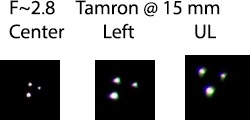
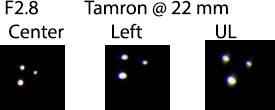
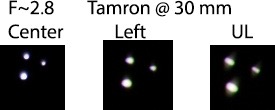
Next is the Sigma Art 24mm f/1.4 lens. Again, this is a relatively recent release, and I had high hopes for it as super fast wide angle that could be used in low light. The F 1.4 maximum aperture would be extremely useful in gathering light in low light situations. Alas, the Coma performance at F 1.4 and F 2.0 is not very good at the edges and corners of the frame. The Coma is however acceptable by F 2.8. For low light situations without stars, the wider apertures would still be very welcome. This lens is acceptably sharp for low light photography although at F 1.4 and 2.0, the edges will be found to be fairly soft. Also, vignetting performance of the Sigma can be called a bit worse than average at wide apertures being nearly -3 EV in the corner and -1.5 EV at the edge of the frame at F 1.4, improving to about -1.5 EV in the corner at F 2.0; but then (Wow!) it gets to be a good -.7 EV in the corner by F 2.8. Sharpness is also much better across the frame by F 2.8. So, although not the best outcome, using this lens at F 2.8 to shoot landscapes with starry skies is an option that will produce very good results.
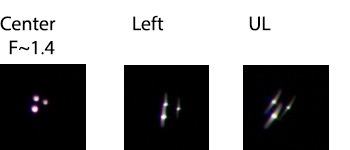
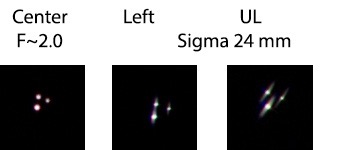
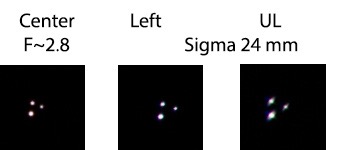
The Rokinon 12mm f/2.8 fisheye is probably not the first lens you would think of for shooting landscapes and low light scenes. However, it does have its charm in some situations and it does cover an extremely wide field of view (180 degs across the diagonal of full frame). I have a more general review of this lens on another page. The image can be defished to give a normal view using some post processing software if you desire. The Coma performance as seen below is not very good, but not the worst seen among the lenses either. In my opinion, it's the wings that some Coma images have that are the most objectionable. A slightly oblong or square shape will still tend to look like a point in an image. The CA seen in these uncorrected crops can be easily cleaned-up in post processing. The sharpness of this lens in the center at F 2.8 is actually quite amazing; however, the edges, are a bit disappointing. You will have to decide on a case by case basis whether or not the softness of the edges in any particular scene is tolerable. For some night scenes it could well still work. The Vignette performance at F 2.8 is a strength of this lens and is only about -1 EV in the corners and half that at the frame edge. I will be trying this lens in some special low light situations where the really wide perspective will work. I expect it to be a decent though not stellar (excuse the pun) performer.
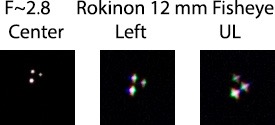
The Rokinon 14mm f/2.8 is a well known low light landscape / starry sky lens. It is recommended on many web sites for its low cost and good performance. Like all the Rokinon lenses this lens is manual focus only, but a good manual focus build is actually a plus for night photography. The Coma performance of this lens wide open is quite good. Stars are essentially circles, and the little bit of CA can e cleaned up in post processing. The lens has exceptional center sharpness at F 2.8 and though not exceptional, the sharpness at the frame edge is certainly decent. Vignette performance is about average with -2.3 EV in the corner of the frame and -1.5 EV at the edge. Overall, its easy to see why this lens is used in so many night / star images.
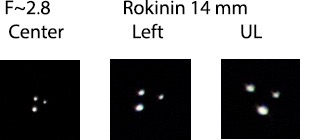
The Rokinon 35mm f/1.4 lens is getting to be a bit on the long end of the interesting focal lengths but is still a lens to consider because of its fast F 1.4 maximum aperture. The Coma performance is not quite as good as the 14mm above, but it's not terrible. Some small wings can be seen on some of the edge shots. On the F 1.4 series or crops, the blooming of the artificial stars in the corner (UL) shot made me think that perhaps refocusing just for the corner would help there. In practice, its doubtful that one would defocus the center of the image to get a better corner so this is just an interesting exercise without much practical significance. The good news here is that his lens is usable at maximum aperture. The bad news is that sharpness, even in the center is not very good at F 1.4. Stopping down to F 2.0 really improve sharpness to a decent level. Vignetting performance is better than average, with about -2 EV in the corner at F 1.4, and about -1.1 EV in the corner at F 2.0. I would recommend using this lens at F 2.0 for low light / starry night shots and would expect to see quite decent performance.

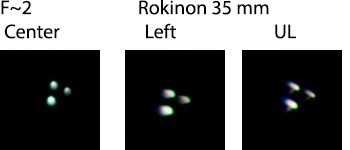
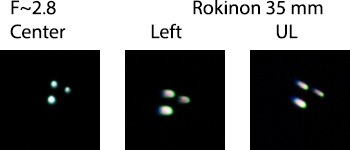
The Zeiss 21mm f/2.8 Distagon lens is another manual focus only lens but unlike the Rokinons, it does have focus confirmation electronics. Zeiss lenses are fairly expensive and you generally get excellence performance and build quality for the money. However, there are sometimes other less expensive lens options that will give equal or even better performance. Don’t be swayed by the name only, look at the performance data. The Coma shots below show performance that is similar to the Sigma 24mm at F 2.8 and performance that is not as good as the Tamron Zoom at 22mm. Still, I would call this acceptable Coma performance that would hardly be noticeable as other than points of star light in an image. The Zeiss has good sharpness performance across the frame at a wide open F 2.8. Vignette performance is about average at about -2 EV in the corner and - 1.2 EV at the edge of the frame.
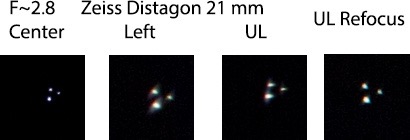
The Canon EF 16-35mm f/4 lens does not really belong here. The F 4 maximum aperture is not a first choice for low light / starry night photography. That said, this is a great “normal” light landscape lens that many Canon shooters are adopting as their favorite wide angle zoom lens. This lens has an advantage over the Tamron in that regular screw-in filters can be used on the Canon. Low light / night shooting does not lend itself to needing filters unless the filter is there to protect the front optic. Dew forming on the front element of a lens is a common problem in night shooting. Some may shoot this at F 4 simply because its in their kit, and at a high ISO (gives high digital noise), it is usable. Hey, I have one so I tested it. The Coma performance at wide open aperture seems to be best at the 16mm wide end of the focal length range and worst at the middle 24 mm. Still, none of the crops are terrible, just not real good. Wide open, this lens has stellar sharpness in the Center of the frame and decent performance at the edges. Vignetting is about average from 16mm with about -2 EV in the corners and becoming better than average at 24mm and 35mm with about -1.3 EV in the extreme corners. Again, this is a great “normal” light lens but not a great choice for low light.
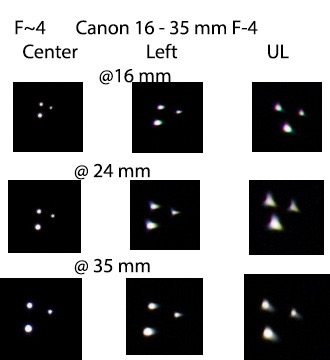
Summary and Conclusions
So, where are the other contenders for a low light wide angle lens? As previously stated, these are the lenses I could get my hands on so these are the ones I tested. I am interested in some of the other choices also and did some research to help fill in some of the holes here.
First, 24mm is a kind of sweet spot for low light / starry night lenses. The trade between a lens wide enough to have long exposures (acceptable star trails) and wide aperture tends to become most favorable at 24mm. This is generally the break point for where lens manufacturers will still make an F 1.4 lens. Any wider and the manufacturing difficulties become such that F 2.8 is more the rule for aperture. This is why I had high hopes for the recently released Sigma 24mm f/1.4 tested here. Other 24s of interest include the Canon 24mm f/1.4 II. Test data I have seen shows that this lens suffers the same Coma problems as the Sigma, and that it only resolves at F 2.8, like the Sigma. However, vignetting is a full stop (-1 EV) worse than the Sigma, even at F 2.8. The manual focus Rokinon/Samyang 24mm f/1.4 is another contender. At F 1.4, this lens has poor sharpness, perhaps too poor even for my lax level of acceptability in night photography. By F 2.0, sharpness is creeping into the OK range. However, Coma performance at both F 1.4 and F 2, though not as bad as the sigma 24mm, is not too good either as wings can definitely be seen. Vignetting is worse than average for this lens and is a stop worse in the corners (-1 EV worse) at F 2.0 and F 2.8 that the Sigma 24mm. I know there are a lot of photographers using the Rokinon 24mm for night and star photograph. Perhaps this gives one some anecdotal evidence that some level of Coma (even small wings) is still OK in the overall scheme of things.
My conclusions from all this pondering so far is that for best all around performance at F 2.8 aperture, the Tamron SP 15-30mm wins. The Sigma 24mm used at F 2.8 is certainly a contender, and the low vignette at F 2.8 may make it somewhat better at the fixed 24mm than the Tamron. The Samyang 14mm and the Tamron at 15mm is a push. I would say that the Zeiss is slightly worse that the Tamron in Coma and Vignette performance at 21mm. The Tamron at 30mm has comparable Coma performance to the Rokinon 35mm at F 2.8 but the Rokinon wins because it can be shot at F 2.0 with acceptable sharpness, coma, and vignette. An even better alternative for a 35mm lens (not tested here) is the Sigma Art 35mm f/1.4. This fairly new lens is usable wide open at F 1.4, has decent sharpness across the frame at this wide open aperture and has very good Coma performance. The only slight downside is that at F 1.4 the vignetting is about -3 EV in the extreme corners and -1.5 EV at the edges of the image (I’m trying to get a copy of this lens to add to my testing files). The Rokinon 12mm Fisheye stands alone if you want or need its particular perspective. Bottom line is that it will take a bag full of lenses to accomplish or in some cases slightly exceed the performance of a single Tamron SP 15-30mm lens.
I’m still waiting for the ideal 24mm f/1.4. Otus anyone?